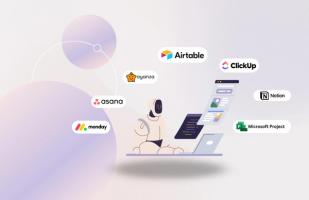7 Best Customer Segmentation Tools in 2025
Editorial Note: We earn a commission from partner links. Commissions do not affect our editors' opinions or evaluations.
Updated December 14, 2024
Published June 7, 2023

Customer segmentation tools will collect your customers’ data from anywhere possible to help you create customer segments. But before we continue, let’s share these results from HubSpot’s state of service report compiled last year.
- 9 out of 10 Americans will choose your business or look the other way because of how you serve your customers.
- 78% of customers back out of purchases because of poor customer experience.
- Last year alone, 49% of Americans switched companies because of how they were treated.
Not to bore you with stats, but do you see that sharing the wrong content with customers can be costly? Why? When it comes to customers, one size never fits all. So how do you ensure those considering buying from you end up doing so and that your business has repeat customers?
Related
We’ve compiled a list of 7 best customer segmentation tools to help you do the groundwork of grouping customers and sending the right message to them at the right time.
But first,
What is customer segmentation?
Customer segmentation is the marketing process of dividing customers into groups. Each segment has customers that share similar interests, characteristics, or patterns. And that can be their gender, age, location, purchase history, website interaction, or even spending habits. Creating customer segments will help you better understand your customers’ needs and interests. That way, your teams form relevant strategies and tailor their efforts toward each segment’s preferences.
And What are customer segmentation tools?
A customer segmentation tool is software with features that pull relevant customer data from multiple channels and then organize customers into segments based on shared traits and behavioral patterns. Your team can quickly unravel product growth opportunities with customer segmentation software and reach out to necessary customers.
Why do you need a customer segmentation tool?
A customer segmentation tool makes analyzing prospects and customers at scale easy. When you use software for customer segmentation, you won’t need to manually sift through several data points to determine the segments to put a customer in—the tool does that for you. Plus, it eliminates human errors and helps you personalize the experiences of various segments.
Here’s why you should get one for your business.
- Better customer knowledge: Customer segmentation uses customer activities like page clicks and spending habits to determine their needs and interests.
- Enhanced customer experience: With what you know about your customers, you can deliver better product offerings and customer service. For example, you can fine-tune your marketing efforts and target ads and promos toward those that need them. Even better, you’ll do that through their preferred channel.
- Increased sales: When you communicate meaningfully with your customers, converting them into paying customers becomes easier. Not only will you meet their needs, but you will also smash your business goals. And since you’ll know the segments to reach, you will save your business resources.
- Improved brand loyalty: By personalizing your efforts, your brand becomes memorable to customers. And the more they believe that you care, the more committed they are to your business, keeping them returning for more.
What are the best customer segmentation tools?
There are dozens of customer segmentation tools, so businesses can get overwhelmed choosing one. But don’t worry, we’ve done the hard work for you, compiling 7 best customer segmentation software options and highlighting their functionality and cost so you can know which ones can help you achieve your business goals.
Let’s dive in!
HubSpot
Our Verdict
Best Overall
HubSpot stands out as a comprehensive marketing platform, offering superior customer segmentation tools along with integrated sales, service, and content management features. Its key strengths lie in delivering detailed customer insights and seamless integration with a host of apps.
Best For
Businesses seeking an All-in-One platform
Price
Free to $800/mo
Discount
10% Off if Billed Annually
Why We Picked it:
From HubSpot’s product and services catalog, you can already see why it’s one of the best customer segmentation tools for any business. HubSpot has excellent customer segmentation features to help you create active and static lists based on various criteria you give it. This tool will also give you incredible insight into every contact so that you can build deeper relationships with your buyers at scale.
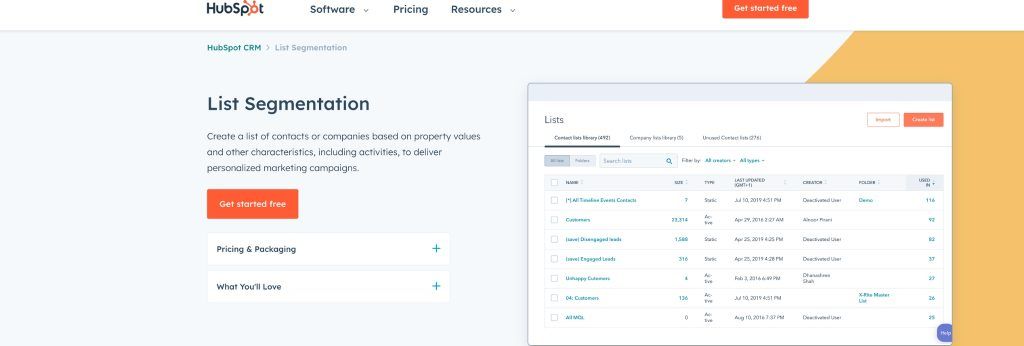
You’ll see each customer’s interaction with your business, from the pages they view to forms they submit and purchases they make, all in one platform. HubSpot also integrates with thousands of apps to automatically capture every customer’s information and behavior to segment them. This customer segmentation tool also gives reports on each segment so you can see how they are doing and how to improve their interaction with your business.
HubSpot works with apps like Gmail, Outlook, and Microsoft Exchange to help you send automated campaigns to selected segments. You can also target ads toward prospects and customers that visit your customer or interact with a specific feature or event.
Please read our HubSpot review for more details.
Price
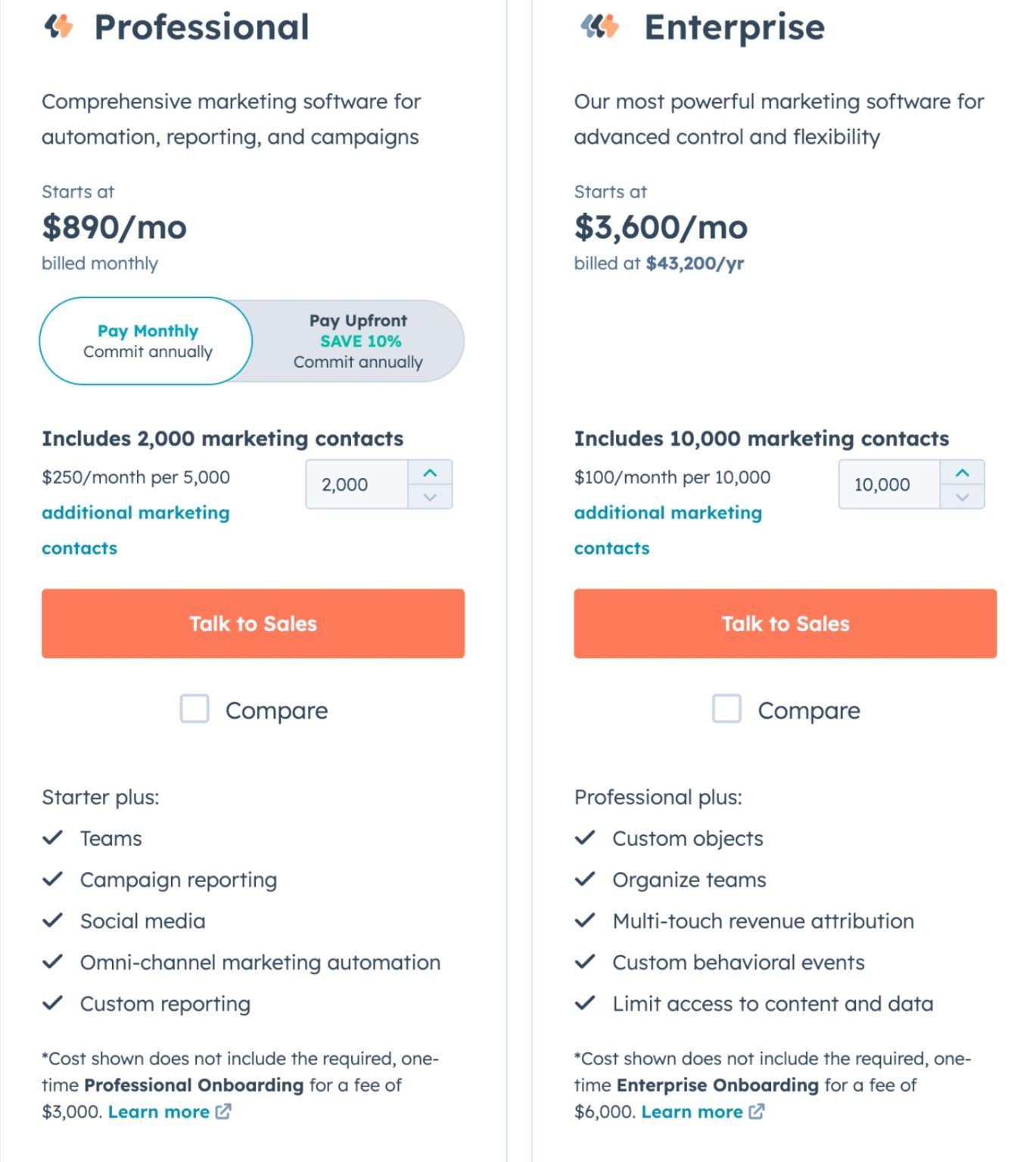
- Free account — Designed for individuals or small business or teams.
- Professional account — Priced at $800 per month or $9,600 annually.
- Enterprise account — Available at $3,600 per month or $43,200 annually.
Bottom Line
The HubSpot platform is the best suite for businesses that want their marketing efforts and other operations like sales, service, and content management in one place. It is also suitable for those who want to try their hands on different customer segmentation features without paying.
ConvertKit
Our Verdict
Best for Segmenting Email Marketing Audiences
ConvertKit offers an impressive range of features for maximizing customer relationships. It provides an intuitive audience management system that allows for customer segmentation based on shared interests and behaviors. This tool enables businesses to automate personalized email campaigns and update segment data promptly to ensure relevant content delivery.
Best For
Email Marketers
Price
Free to $29/mo
Discount
Up to 40% Off If Billed Annually
Why We Picked It
This marketing platform has the features you need to maximize customer relationships. With ConvertKit’s audience management system, you can segment and organize your customers based on shared interests and behaviors. Use a visual builder to define your segment parameters and decide how you want to interact with each group. Segment customers based on actions like new purchases, email engagement, link clicks, form completion, or sign-ups.
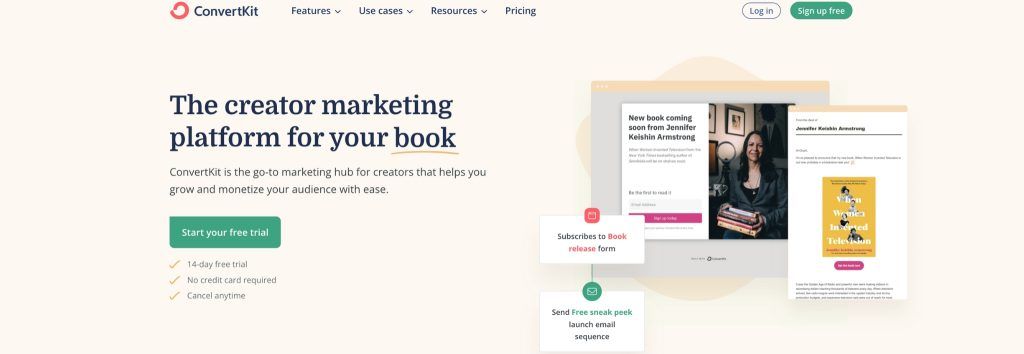
ConvertKit allows you to choose several parameters for segmenting your customers. For instance, you can segment them according to their interest, such as those who want to use a specific product feature. ConvertKit also helps you send personalized emails to customer segments so your content lands in the right email.
You can even create email templates to reuse for different customer journey stages. For example, you can automate a welcome email to new subscribers or send thank you emails to customers after subscribing to a new feature or joining your monthly webinar.
Also, when you launch a new product, you can pitch it to those segments that have shown interest in it. And after purchasing the product, ConvertKit can update the segment’s data so they don’t get irrelevant content, such as those meant for new customers interested in that particular product.
Please read our ultimate ConvertKit review for more details.
Price
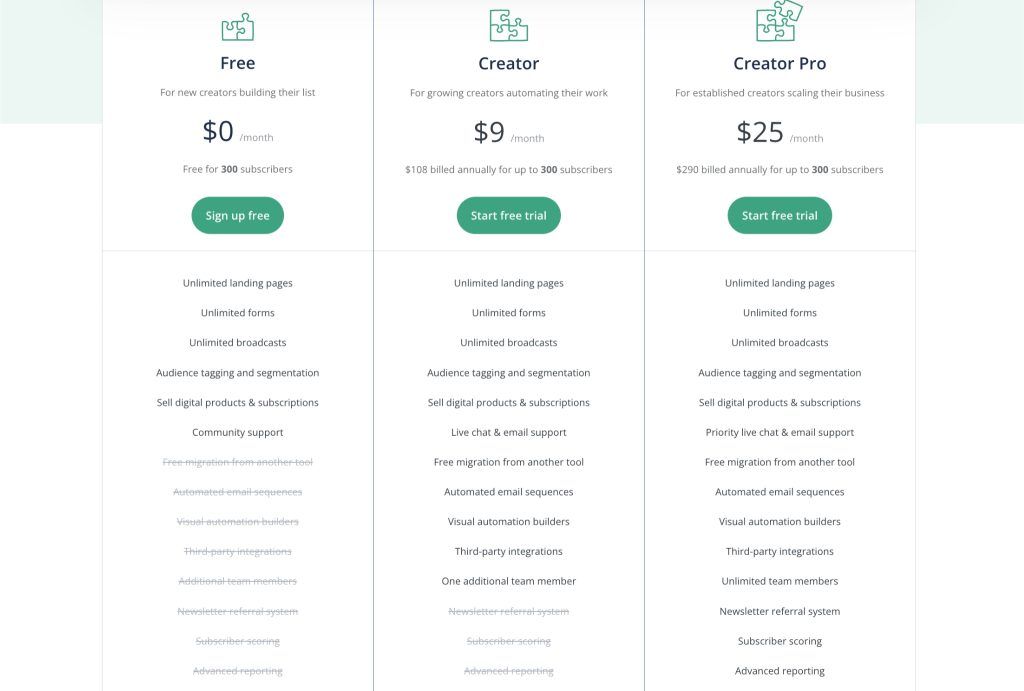
- Free account — Suited for new business owners and creators seeking to draw initial attention and build audience through personalized email campaigns.
- Creator account — Priced at $15 per month up to 300 subscribers or $108 annually for up to 300 subscribers
- Creator Pro account — $29 per month up to 300 subscribers or $290 annually for up to 300 subscribers
Bottom Line
ConvertKit is best for those with several lists of email subscribers or who want to grow those lists. It is ideal for businesses looking to automate personalized emails for distinct stages of the customer journey.
Segment
Our Verdict
Best for Automated Segmentation
Segment emerges as an effective tool for businesses of any size seeking to collect and organize real-time data from multiple touchpoints. It excels in recognizing customer behavior patterns and segmenting customers accordingly. With integrations over 400 third-party tools, it ensures no customer interaction goes unnoticed.
Best For
Data-driven Enterprises
Price
Free to $120/mo
Discount
None
Why We Picked It
Whether you’re an SMB or a large enterprise, Segment can help you collect data from touchpoints like your company website and social media platforms. Segment collects and organizes real-time data from anywhere it finds your customers interacting with your business. It also identifies behavioral patterns and new customer insights and divides your customers into groups where members share interests.

You can use the collated data to deepen your customer relationships. Segment also integrates nicely with over 400 third-party tools, so you don’t lose track of a new customer or interaction. It then unifies the data into groups and user profiles your teams can access. The segmentation tool also offers daily reporting to show you how your segments are doing.
The categories Segment creates will allow you to target your efforts, especially personalizing engagements with different types of customers across various communication channels. For example, with its Personas feature, your team can tailor campaigns according to customer needs, delivering personalized marketing ads to specific customers.
Price
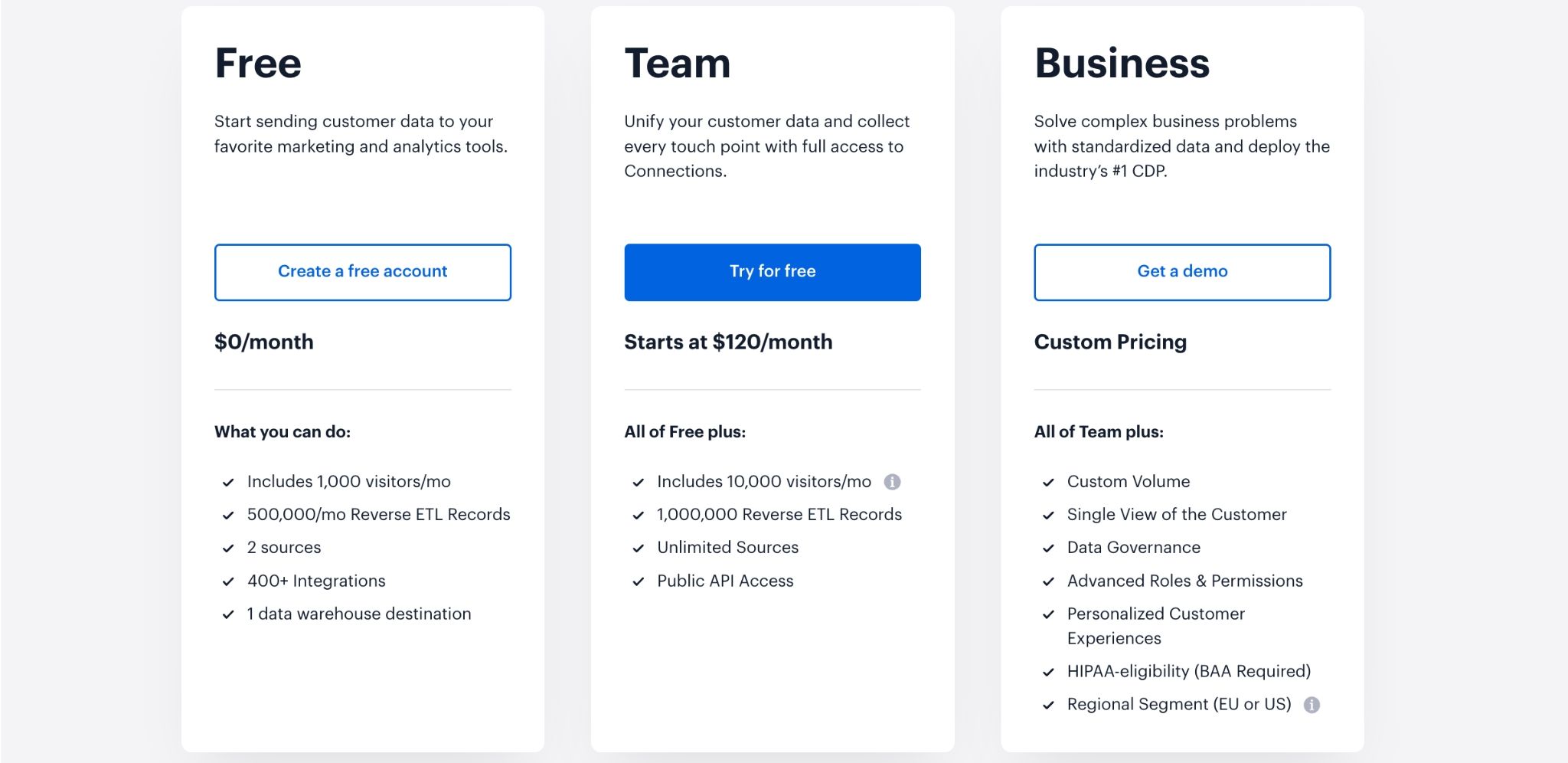
- Free account — Designed for new developers
- Team account — Starts at $120 per month
- Business account — Pricing details provided upon request.
Bottom Line
If you’re looking for a tool with specifically-built features for automated customer segmentation and multi-channel communications with customers, you should go for this Twilio product.
Baremetrics
Our Verdict
Best for Subscription-based Businesses
Baremetrics shines with its built-in customer segmentation dashboard that delivers clear comparative insights on different customer groups. The ability to track various activities, along with its extensive integration capabilities, makes it a robust tool for companies that want to understand their customers better and grow.
Best For
SaaS Companies
Price
$69/mo to $1000/mo
Discount
20% Off If Billed Annually
Why We Picked It
Baremetrics has a built-in customer segmentation dashboard to help you group your customers and give you clear comparative insights on segments. The tool allows you to create and save multiple customer segments within seconds. You’ll also see where your customers are in their journeys and get an overview of their interactions with your business over time.
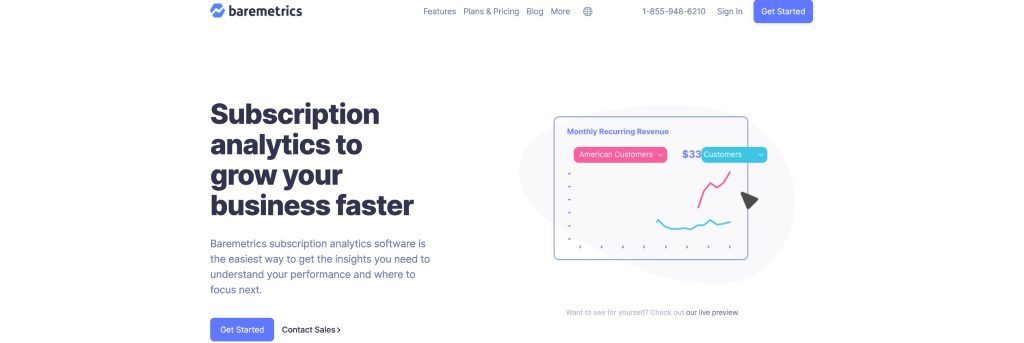
You can track activities like signups, cancellations, payments, refunds, upgrades, and downgrades on your customer profiles. Another thing this segmenting tool does is show you the performance of different customers. You’ll see their growth level and how they’ve contributed to your company’s growth. These data will better direct your marketing plans, helping you create experiences that can improve the groups that are not performing well.
Baremetrics also enables smooth integration with tools like Shopify, Stripe, and Slack. And it offers an API for connecting to those it typically doesn’t integrate with—all so you can access all the resources you need to segment customers. This tool also keeps updating your customer data from multiple sources so you can account for every customer. For example, you’ll know when a customer segment reacts to a new product feature or recent bug.
Price

- Metrics — Starts at $129 per month or $108 per month billed annually up to 9k MRR with grow by knowing your Saas business in real-time feature.
- Recover — Starts at $69 per month or $58 per month billed annually up to 9k MRR with essential tool to help you combat failed payments feature.
- Cancellation Insights — Starts at $129 per month or $108 per month billed annually up to 9k MRR with learn why your customers cancel and bring them back feature.
- Forecase+ — $1000 per month with see intelligent MRR projections with configurable options.
Bottom Line
If you’re a subscription-based company, you’ll love the specific functions that Baremetrics provides to help you work with those using your service.
Kissmetrics
Our Verdict
Best for Monitoring Customer Journey
Kissmetrics is a marketing analytics tool excelling in customer segmentation. It centralizes data from popular apps, providing conversion insights across customer segments. Its standout feature is its ability to monitor customer journeys, helping businesses understand common patterns and make data-informed decisions.
Best For
eCommerce Businesses
Price
$299/mo to $499/mo
Discount
None
Why We Picked It
Kissmetrics is a marketing analytics tool that can help you with segmenting customers based on your chosen categories, such as active users, specific page viewers, and specific feature users. You can then design future emails, campaigns, and products that are necessary to the segments you have. Kissmetrics can also help you target campaigns toward the segments that require them. That way, you’re connecting to the right group.

This tool also offers integrations with popular apps like Slack, Zapier, and CallRail so that it can effectively collate customer data and then keep them all in its central dashboard space. For instance, with analytic tools, you’ll detect whether or not your first-time or repeat purchaser segments are growing or shrinking. You’ll also see how well different segments are converting, so you can double down on those that need more attention.
Like those customers that keep coming back, you’ll be able to see what they have in common or how you got them and use their customer journey reports to determine the steps you need to take on other customer segments.
Price
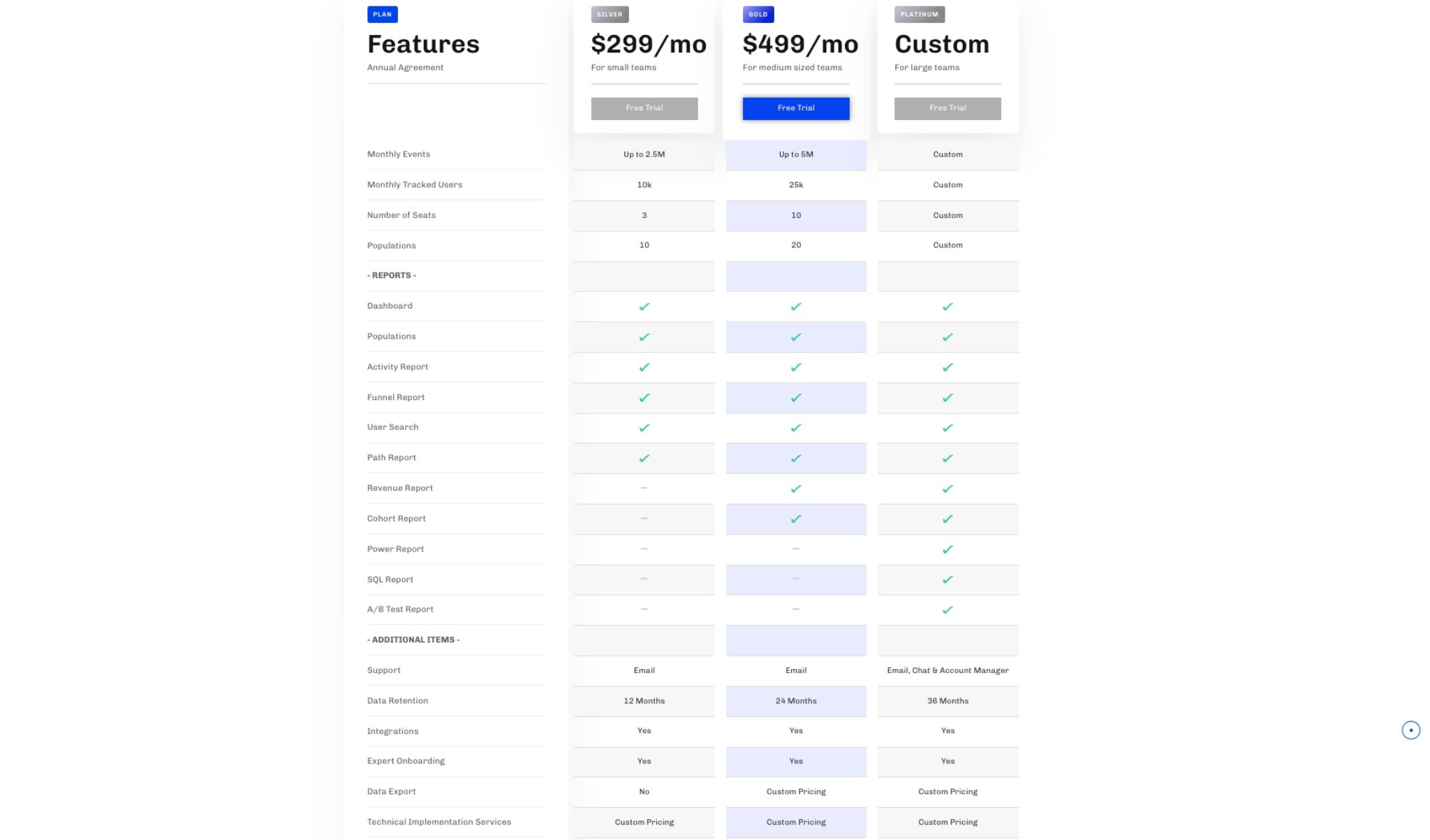
- Silver — $299 per month designed for small teams
- Gold — $499 per month designed for medium sized teams
- Platinum — Pricing details provided upon request.
Bottom Line
Kissmetrics is what you need when you intend to monitor customer journeys and the details of how they interact with your business. Companies seeking to direct marketing campaigns to specific customer groups will find Kissmetrics beneficial.
Heap
Our Verdict
Best for Non-tech Savvy Users
Heap is a low-code platform providing automated customer segmentation based on user interactions. Its key strength is delivering visual reports on customer journeys, aiding in conversion and retention strategies. Moreover, it enables targeted communication based on behavior-driven cohorts.
Best For
Non-tech Savvy Users
Price
Free to Pricing details provided upon request.
Discount
None
Why We Picked It
Heap is a digital insights platform that organizes data to help companies better understand their customers. Heap’s customer segmentation model is such that it records every action your customers take when browsing your website or synced apps. It then recommends the next steps to improve your website and customer experience.
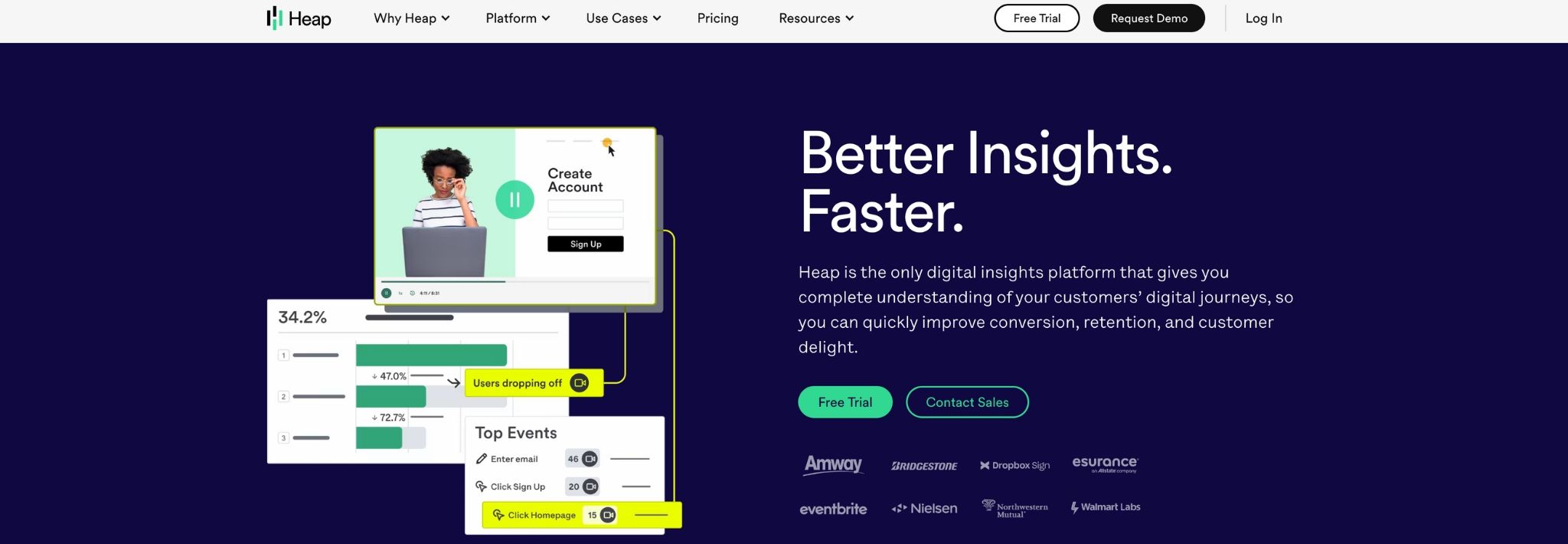
The automated platform offers features like auto capture, custom tracking, and server-side events. It works with popular tools like Salesforce, helping you create comprehensive datasets. The tool tracks the customer journey, identifying potential buyers, previous purchasers, or those yet to engage despite multiple site visits.
Heap provides visual reports that give you insight into your customer journeys so you can make relevant efforts on their conversion and retention. You’ll also see how the different segments use your features and which provide the most value to your business growth. And you can pull user CSV files and segment details for additional third-party analysis.
You can also personalize prospect and customer communication by targeting behavior-driven cohorts. For example, you can build targeted user guides for specific custom segments.
Price
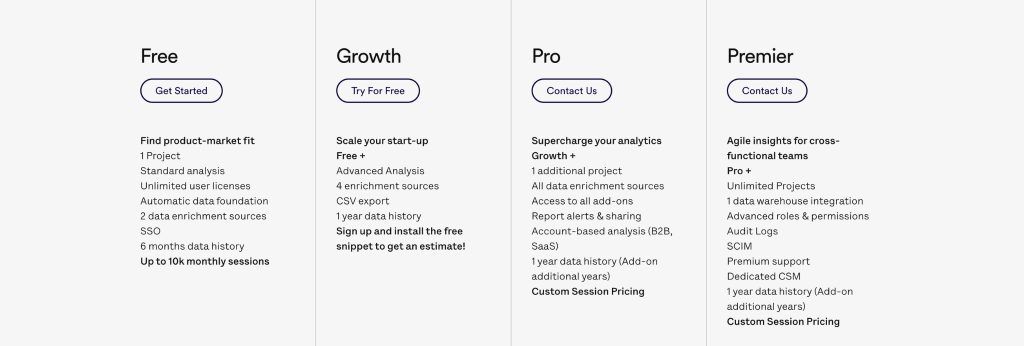
- Free Account — Up to 10k monthly sesions
- Growth Account — Offer Free Trail, sign up and install the free snippet to get an estimate.
- Pro Account — Pricing details provided upon request.
- Premier Account — Pricing details provided upon request.
Bottom Line
Heap is a low-code platform, and that makes it easy to use and suitable for those without tech experience.
Userpilot
Our Verdict
Best for Engagement Tracking and Reporting
Userpilot excels in advanced customer segmentation and engagement tracking. It delivers personalized content, identifies user behavior roadblocks, and offers comprehensive insights. Its robust capabilities make it a worthwhile choice for businesses that prioritize function over cost.
Best For
Business seeking detailed engagement tracking
Price
Free to $ 299/mo
Discount
17% Off If Billed Annually
Why We Picked It
Userpilot has advanced segmentation features you need to build better customer relationships. You can track customer engagement and characteristics, such as the products or pages that catch their attention, which devices they use, where they live, how active they are, and which stage they are in their journey. Userpilot allows you to customize segments for different customer uses, including how they use your features and how often they click a tooltip or any other element on your business website.

It also allows you to integrate with other tools where you source customer data from or communicate with your customers so that it can access all the data it needs to show you exactly what’s going on in each customer’s journey. Apart from grouping customers with shared characteristics into segments, Userpilot also helps you share relevant content with them. That way, you can engage customers the right way. But it doesn’t stop there—it tracks how each customer segment interacts with your business to find stalled users and detect what prevents customers from reaching certain milestones.
Price
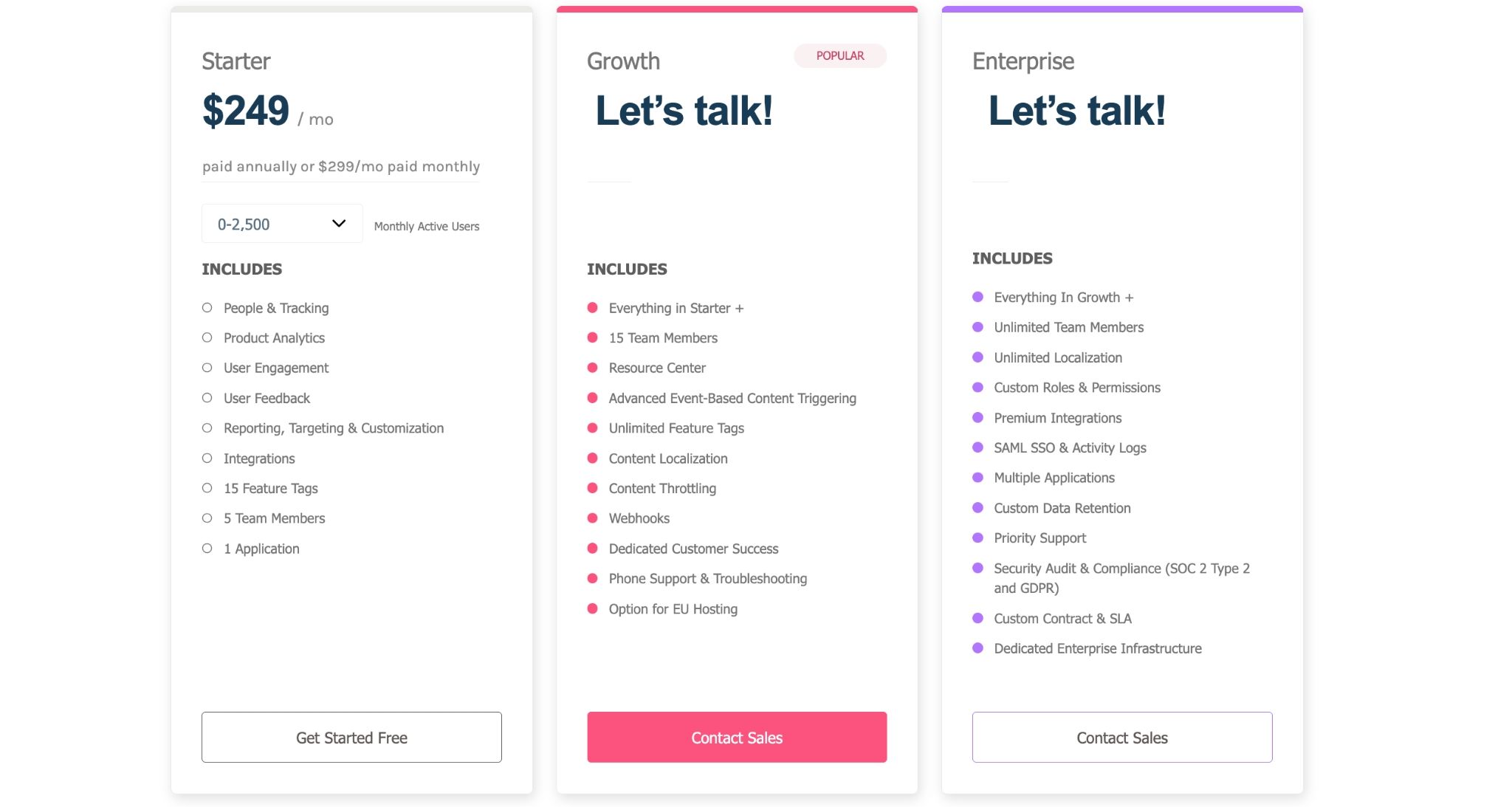
- Starter Account — Starting from free, $299 per month or $249 per month when billed annually.
- Growth Account — Pricing details provided upon request.
- Enterprise Account — Pricing details provided upon request.
Bottom Line
Userpilot is suitable for those seeking a tool that can help them segment their customers and share reports on how they’re doing without minding the cost.
How much are customer segmentation tools?
Customer segmentation tools vary in price. Some offer users plan packages so that you can choose one with features and functionality that fit your business. Others require you to share details such as your business size, customer size, and what you need so that they can quote a price based on your cart.
Some best customer segmentation tools, like Hubspot, Heap, Baremetrics, and ConvertKit, offer free versions, but we won’t recommend that you stick to them. With their limited user and monthly session capacity and the likes, you won’t get the best results using them. Some tools provide everything you need for segmentation, communication, and reporting. Others might need integration with additional, potentially paid, tools.
Costs are typically based on your customer count and tool requirements. Generally, customer segmentation tools are free or charge a few hundred dollars per month. Long-term subscriptions may offer discounts.
What should you consider when choosing customer segmentation software?
There are several customer segmentation tools, and each works differently in how they source customer data, segment customers, or run its customer segmentation analysis. One may have limited applications but integrate nicely with plenty of marketing and customer engagement tools, while another software has all that you need in one platform.
Choosing one then depends on your business needs, but these are the main things to look out for.
Features
First, involve your product, marketing, and analytics teams when choosing a customer segmentation tool. Next, select a tool with the right features to help you meet your goals. For instance, go for one that can help you find the kind of data and insights your teams need, even communicate with segments across the multiple channels you use.
Organization
The right customer segmentation software should show you who your customers are and what they want from your business. That picture should also be organized in shareable charts and graphs that are easy to examine and that you can share.
Customizability
A good customer segmentation model is one that not only allows you to access different segments but customize as many segments as you want based on unique interests or characteristics.
Scalability
Since your aim is to grow, your choice of software should be one that can grow with you. And that means having features that can accommodate more customers, updates, and integrations with other apps you might need later.
Integration capability
Customer segmentation tools must enable smooth integration with third-party apps, such as marketing, email marketing, and analytics. You’ll need them to activate segment reports.
Ease of use
Choose an easy-to-use tool, especially for non-tech-savvy users. Avoid tools that restrict solution use or make understanding their data difficult.
Value for money
Most customer segmentation tools fix their prices based on the number of customers you have. So, find out the capacity of each plan, or speak with their team for custom quotes. Also, remember to consider discounts you’ll get from annual subscriptions, as opposed to month-to-month payments, and necessary add-ons or third-party apps you might need to pay for. And for those offering free versions, check their offerings. Can they cater to your needs?
5 tips on how to get the best results with customer segmentation tools
Here’s how to make the most of your customer segmentation software.
1. Make communication customer-focused
Use segment information to decide which content or products will bring the most value to your customers. Then, draw a plan on how to engage with each segment. You can also consider new products around the unique needs of each segment.
2. Use accurate data
Ensure that your data collection forms have relevant questions and accurate parameters. Also, do periodic data cleaning to ensure you’re not using outdated data parameters.
3. Give your teams access to the tool
Remember how it’s good to involve your teams when choosing a tool? You also need to give them access to the segments so that they can use the customer segmentation data and reports to achieve your goals.
4. Don’t over-target priority segments
While spending resources on segments that make up a significant portion of your sales is good, don’t go overboard with them and leave out other segments. Every segment is important, so attend to them so you don’t lose customers.
5. Run customer segmentation analysis regularly
Running regular analysis of your customer segments can help you keep segments useful. You’ll also detect those not performing so well and know when to take necessary actions. While customer segmentation machine learning and automation can help you detect changing data, you’ll need to set it to do that at specified intervals.
An extra one for you…
Never hesitate to call customer support whenever you need help. For instance, if you find understanding how to use a new feature challenging, talk to the team. After all, you’ve paid them.
It’s time to nail your customers
Customer segmentation tools will show you a clear picture of your current customers and leads, and that will help you target them more efficiently. But if you don’t choose the right one for your business, you can easily miss out on what these tools offer—enhanced customer relationship that leads to business growth. Thankfully, our recommendations will guide you to become one of the 10% of American businesses customers keep choosing.
Share This Post
Della Yang
Della Yang is a marketing professional with a passion for the ever-changing digital landscape. She frequently writes tech news and reviews, sharing her knowledge and insights through blogs and various online platforms.
Allow cookies
This website uses cookies to enhance the user experience and for essential analytics purposes. By continuing to use the site, you agree to our use of cookies.








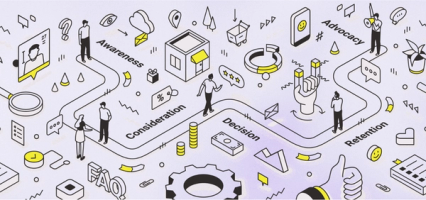
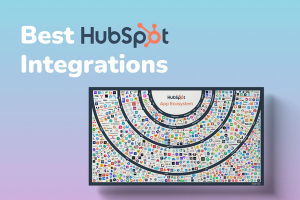
![9 Best Free AI Apps for iPhone and Android for Everyday Tasks [2025]](https://cdn.sanity.io/images/isy356iq/production/c78721c8cd032ff669a9a96b586ffcb32521e98c-1200x800.jpg?h=200)
![11 Best AI Website Builders for Every Need [2025]](https://cdn.sanity.io/images/isy356iq/production/23668ac08262c43eeafaee559b1fb26d05f9bb81-1200x800.jpg?h=200)

![Top 11 AI Selfie Generators You Should Try Today [2025]](https://cdn.sanity.io/images/isy356iq/production/6b53b70744e205a2e00f78b0752a08b712771be0-1200x800.png?h=200)
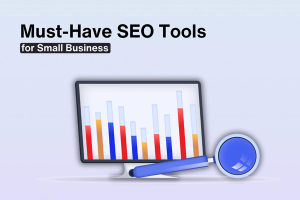
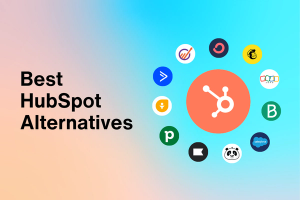

![17 Best Free and Paid Canva Alternatives for Graphic Design [2025]](https://cdn.sanity.io/images/isy356iq/production/2e7d115c608fcf806e2c38d35392f852cd6057ae-1200x800.jpg?h=200)
